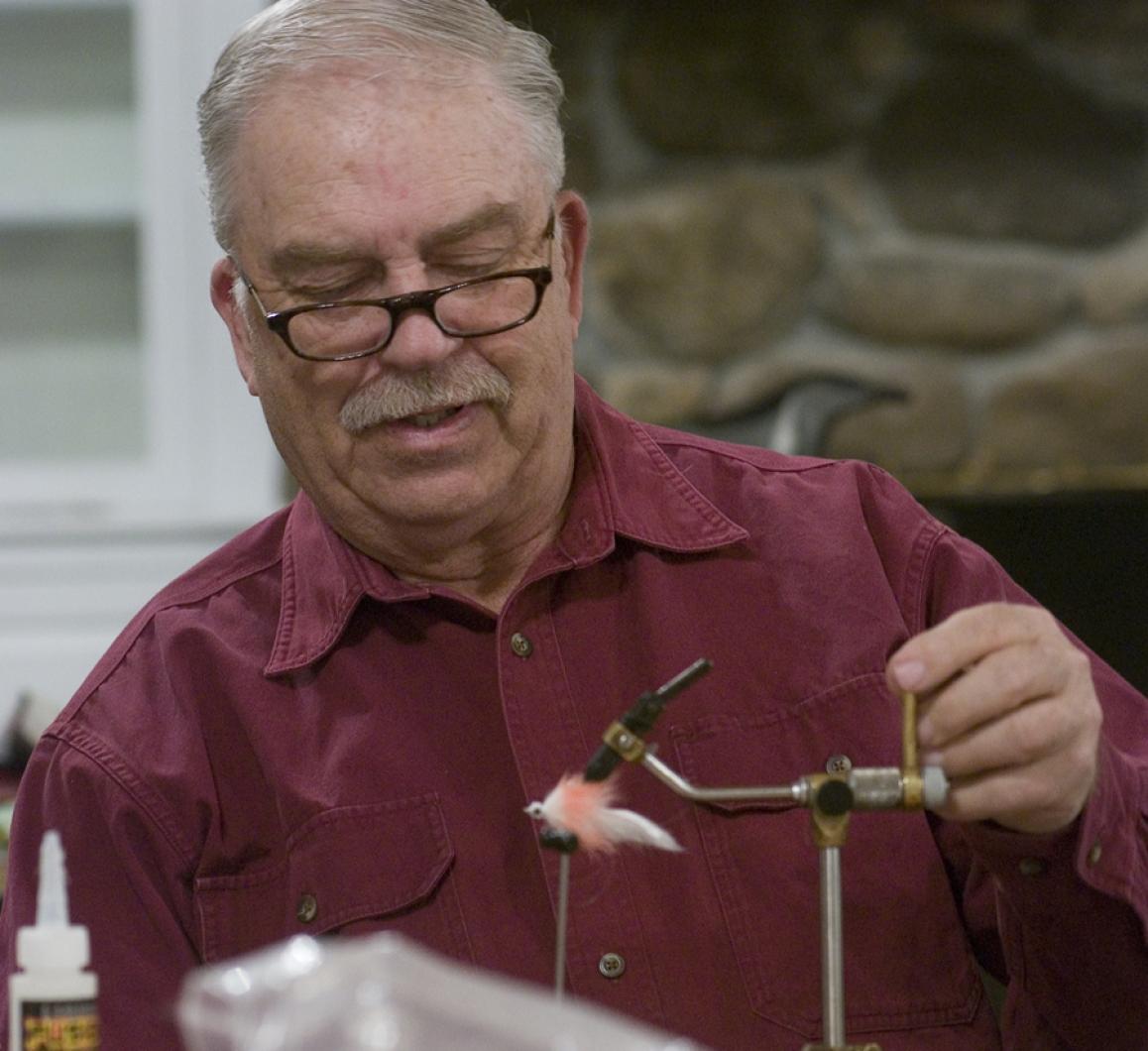They meet in the deep of winter and talk about summer fishing. Though the temperature outside is in the 20s on this Monday night and icicles hang from the eaves, the room inside the Martha’s Vineyard Rod and Gun Club in Edgartown is infused with the warmth of a July day on the water with the sun beating down and the false albacore running off the Menemsha jetty. This is fly-tying night, and it has been going on every Monday night here since January.
The anglers speak in low tones. Their sentences are punctuated by pieces of colorful debris falling to the floor and piling up at their feet. They wrap sharp hooks with strands of thread, feathers, deer hair and high-tech materials with modern names like Mylar Flashabou and Krystal Flash.
And while their fingers are busy tying identical flies, stories fills the air.
For more than 20 years anglers have gathered in the quiet winter months at the club for this activity, and this winter the weekly event is especially pleasant since the club was completely renovated last year. The interior lighting is warm and bright, and a hot fire glows in the fireplace, no longer smoking up the room the way it used to, a reminder that sometimes new is better than old.
Last year during construction, the group met at The Anchors.
Cooper A. (Coop) Gilkes 3rd of Edgartown is the lead instructor. Coop has been counseling, teaching and providing gear to Island fly-fishermen for 30 years. From January through March, he is the top volunteer at the club on Monday nights. He’s been running the workshop for 20 years.
Reflecting back over those years, Mr. Gilkes said the fish haven’t changed, though they do seem more scarce than they were a few years ago. But the art of fly-tying has changed. There are many more materials available to choose from, now that shiny, colorful synthetics have exploded into the fly-fishing world.
Unlike freshwater flies, which imitate insects, saltwater flies are artful creations that resemble bait fish, intended of course to attract striped bass, false albacore, bonito and bluefish.
The flies are light and hardly weigh more than the hidden hook they are tied to. No single fly is heavy enough to cast, but this is part of the art of fly-casting, which relies on the weight of the line and the skill of the fisherman to send it 40 to 80 feet out into the water.
And as with a lure, the fisherman retrieves the fly gradually and with deft movement. A fly-fisherman will tell you that he can feel a fish as it hits the fly more keenly than the conventional fisherman with a spinning reel.
The stories told on this night are all about making that connection with a moving creature circling beneath the water — and which flies are the best for accomplishing the task.
Mr. Gilkes said he ties many varieties of flies through the winter to be sure he has plenty of choices in his fly bag once the fish start running. On this night, he is teaching and reviewing the art of making a so-called bunny fly, which resembles the cotton tail on a hopping bunny. The fly is in fact made of bunny parts; strips of rabbit fur are wrapped around a hook and the end result is a fly that will look like a swimming ball of cotton with a tail in the water.
Mr. Gilkes reminds those gathered that this creation is a standard in everyone’s fly bag.
Mary Filiault of Edgartown ties a red bunny. An avid angler, she has been attending fly-tying nights for many years.
Mr. Gilkes is making a two-color bunny fly that he promises will lure a false albacore from a fast-moving school when nothing else works. Fishermen nod their heads, keeping their eyes on the task at hand.
“This is my night out,” said John Peipon of Vineyard Haven. “Some guys will go to the bar. I go fly-tying.”
Mr. Peipon praised the many talented fishermen on the Vineyard. When it comes to saltwater fly-fishing, the Island has some of the best, he said. In June, the rod and gun club hosts a fly-fishing catch and release tournament that over the years has attracted fishermen from all over the country and from distant countries. In addition to fishing, participants enjoy swapping flies.
Joining the conversation about the wide array of Island fishermen, Mr. Gilkes pulls out two flies made by David W. Skok, a Winthrop resident who comes to the Vineyard to fly-fish.
Ed Lepore of Vineyard Haven is another name that comes up in the conversation about well-respected fly-tyers.
“You can learn the basics in a little while,” observed Mr. Peipon. At the other end of the spectrum, he added: “You can spend a lifetime and it will drive you crazy.”
Mr. Gilkes agreed. “It is like fishing with a pile of keys. On any given night, only one key unlocks,” he said.
Mr. Gilkes recalled fishing at night at Lobsterville Beach years ago and noticing that no one was catching any fish except one person. That angler was using a black bunny fly. Mr. Gilkes said he had made many bunny flies over the years, but on that particular night he didn’t have the right one. Fish can be fickle that way.
And while Mr. Gilkes is without question one of the most highly respected fishermen on the Vineyard, on this night he joins the rank and file, admitting that he too at times is challenged by the sport. “I haven’t figured it out,” he said.
T he one-time fee for joining Monday night fly-tying is $20. An addtional $10 is collected each night for materials. Sessions begin at 7 p.m. All are welcome to attend.







Comments
Comment policy »